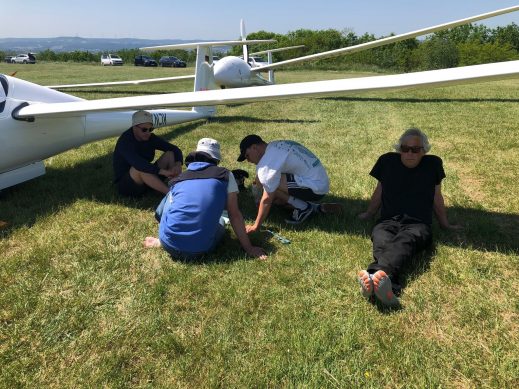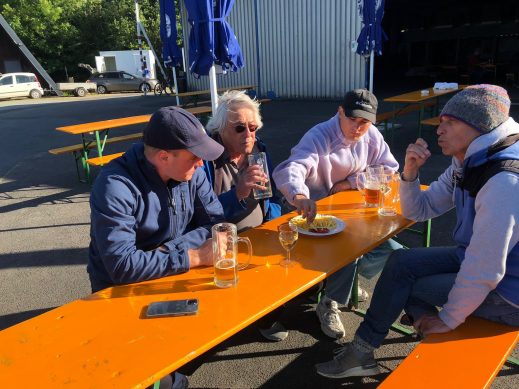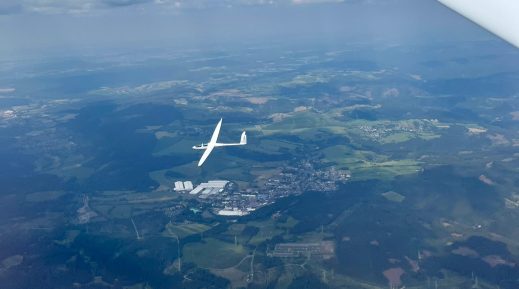Laurenz Theisinger, German champion in the two-seater class
Laurenz fulfilled his childhood dream at the German championships in the two-seater class: The German championship title. In his report, he tells us how it all went down.
The back story
I flew my first competition in a two-seater (Nitra) with my father at the tender age of 14, but only as ballast and for large parts of the flight – due to the side effects of tablets for travel sickness – I was asleep. Although my previous DM experience was limited to the 15m class, I had always flirted with the idea of flying a two-seater competition with my father again at some point. This opportunity presented itself to me as I was able to swap my 18m qualification place (Lachen-Speyerdorf 2022) for a starting place at the Dosis. The choice of aircraft was not difficult, as our club (DJK Landau) has been the proud owner of an ASG 32 since 2019.
Team Landau
As my uncle Martin and his proven co-pilot Yannick Frey have been at home in the two-seater class for several years, this also gave us the opportunity to form an extremely interesting team: My father and Martin can look back on a very successful time as a team in the 15m class, my (competition) flying has been characterized by flying with my father since the beginning and Yannick and I have also flown competitions as a team. So the only novelty here was the team flight by Martin and me. What was planned as a relaxed team flight quickly proved to be a guarantee of success: both on the ground and in the air, we complemented each other on crucial points, passed the balls to each other and were able to avoid serious mistakes through dialectical decision-making.
Especially in critical situations, I was able to rely on the experience of my co-pilot and thus defuse them.
The competition
We were blessed in terms of the weather: a stationary high gave us ten competition days, most of which were characterized by good cloudy thermals. The blue sections proved to be challenging time and again and the change in landscape typical of the competition area was also challenging. Precise weather forecasts and well-planned routes made ten brilliant air races possible, which stretched from the Fichtelgebirge to the Erzgebirge, the Bavarian Forest, the Swabian Alb and the eastern Odenwald to the Thuringian Forest. The good weather conditions in combination with frequent use of the PEV start allowed for mostly creative flights, which allowed Martin and I to leave the competition out of the equation and rely on our ideas and skills when choosing the time of take-off and the course.
Competition day 3 - "A change of pace"
The 450km racing task took us into the Bavarian Forest to the Austrian border, back along the race route towards Falkenstein and from there home via the Tachov turnaround (Czech Republic).
After a relatively late departure, we struggled through lightning-blue, moderately blue weather via the Cham basin to the Bavarian Forest. Only there, south of Cham, did cumuli with a high base appear. While gliding there, we saw numerous classmates who had flown off earlier at ant-knee height on many slopes in search of the saving connection to the good thermals. Fortunately, we were able to glide a few ridges further with a little more altitude and find the connection relatively easily. Then a race of the best kind started, with climb rates of up to 4m and a base of almost 3000m to the first turn and from there back to the second turn. Unfortunately, we were only able to take advantage of these dream conditions for a short time, as it turned blue again shortly before the second turn. We missed the optimum jump with maximum altitude because, as so often, we couldn’t find a good climb in the last clouds. The way home via Tachov was then completely blue again, but still reliable. Unfortunately, after the first two circles in the blue, we felt like we had the whole class in our beard, as most of them managed to leave the cloud streets at the base and our previously gained lead had evaporated. After a “visually exciting” final approach from the east over the Fichtelberg, we were nevertheless home with a solid result for the day.
Competition day 7 - "damage control"
A 380km racing task was on the agenda, first to the Erzgebirge and then to the Haßfurt area and back. The Erzgebirge showed itself from its best side. With over 200km/h and only a few circles, we headed towards the first turn. However, this was a little to the north of the race track. Everyone flew almost abeam of the turnaround and then left out to the turnaround into the weaker weather. We thought we could do without this hook for the way back and wanted to return diagonally to the main ridge, which then went completely wrong. Despite reasonably good optics, one climb followed another without really finding anything useful. The fact that shortly afterwards we saw the competition passing by a little to the south and 1000m higher up didn’t really make it any better. Our team partner Martin was quickly 40km ahead.
But the further course played into our hands, it was blue in the west and much weaker. As we were able to fly into the blue with a lot of confidence thanks to the information from Martin, we managed to catch up with the field by leaving the thermals in the right time and flying quickly ahead.
After the first turn, we would not have thought it possible that we would come home in 11th place for the day.
Competition day 8 - "Back on Track"
The eighth consecutive scoring day was not easy from a meteorological point of view, with the east threatening overdevelopments and the west expected to be blue. So all classes had AAT in the NW quadrant, for us with 2.5 hours over three turning areas. It wasn’t easy at the airfield before take-off, the weather was soggy and slow to get going. But then it quickly improved and we took off early. It went well to the west, we flew the first sector pretty much to the end and then turned into the northern sector. The weather forecast turned out to be correct, the good cumulus clouds were to the east of the sector and it was quite blue in the sector itself. But while we were still in doubt about the right course, a line of fluff became visible in the middle of the sector, which was more than we dared to hope for. Three 3m+ beards quickly brought us to the northern edge of the sector and back towards the last sector. As we had already covered a lot of ground in the first two turning areas, we now only flew south until we spotted the good line home. The last leg was quickly completed and a long final approach without a circle increased our average speed to 130 km/h. This meant first and second place for us on the day and we were both ahead again in the overall standings.
Last competition day - "The finish"
On the last day, we visited the Thuringian Forest for the first time. First towards the Erzgebirge to Adorf and then to Suhl and back, “only” 265km.
But as on almost every day, the best conditions alternated with difficult passages.
The instability had steadily increased over the last few days, and we got a taste of this right at the start. We were the penultimate aircraft to take off, the base was already well above 2000m and the first signs of shuddering were visible. The light rain began to fall at 200m during the tow, with the optics cracking a little south of the release area. We had to glide for a long time until we got a deep connection – would it have been enough to get back to the airfield? AS2, which started last, had to land again straight away, but was towed in again straight away. The whole field was then able to take off at high altitude without any problems. Incidentally, we heard that the second turn in Suhl had just been rained off in a heavy shower. Up to the first turn today: awesome. The second leg into the Thuringian Forest was then soggy again. But also today, as almost every day: although there were many doses together, there were hardly any groups. Everyone tried their own thing, sometimes with brief success, but then someone else had a better idea. When we finally arrived in the Thuringian Forest, the conditions improved again. However, it soon became clear that Suhl was dry again, but still completely dead.
Some risked going in and straight back out, others tried the western route, we wanted to minimize the risk and, like many others, chose the eastern option. After losing a bit of water, we arrived back in safe territory and the subsequent improvement in the weather allowed us to make a clean final approach to Bindlacher Berg.
Das Flugzeug
Although I only had about 10 flying hours on the 32 before the DM, I immediately felt at home in it. What begins on the ground with the impression of the highest quality and value continues in the air. I was particularly positively surprised by the feedback that the glider gave me about the air mass. I am less surprised, but even more impressed by the AS-typical high-speed glide performance, which in my opinion is unrivaled in the two-seater class. These were particularly impressive for me on day 4 of the competition: the only classic Blue thermal day that punished impatience on take-off. I was almost the last to take off and although I caught up with the packs quickly, I reduced the water ballast so as not to run into the L-position climbing Arcus in the thermals. The 32 enabled me to glide effortlessly past the majority of the field despite the lower wing loading between the various beards and to be in the right position in the last thermal. This day gave me the day’s victory and a jump to the top of the overall standings. Now that I have gotten to know the glider intensively under competition conditions, it irritates me all the more that the 32 does not appear more often in the field of participants.
The German championship title is a childhood dream come true for me. This success is crowned by the fact that I was able to win the title together with my father and in a team with my uncle.





